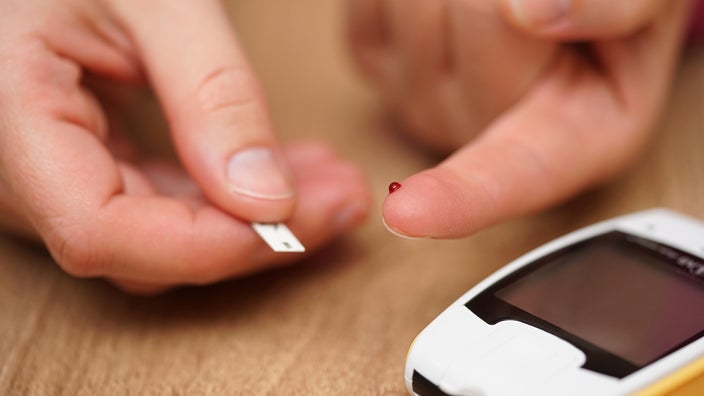
Diabetic Test Strips: Where to Buy and How to Save
Key takeaways:
Diabetic test strips are important tools for monitoring blood glucose (sugar) levels, especially if you have Type 1 or Type 2 diabetes.
Test strips are available over the counter (OTC) at pharmacies, online, and through several subscription services. These options make it easier to find what works for you.
Many insurance plans cover test strips, but coverage varies based on your specific plan and location.
If you don’t have insurance or are underinsured, discount programs and coupons can help lower costs. You can save money with a free GoodRx coupon if your prescriber writes you a prescription for your test strips.
Table of contents

If you have diabetes, checking your blood glucose (sugar) at home is likely an important part of your daily routine. One common way to check your blood glucose is with a blood glucose meter (glucometer) and diabetic test strips.
These small tools are powerful. They give you real-time information about your readings and help you make smarter choices about food, medications, and activities. Keeping track of your blood glucose levels can help you avoid serious health issues from diabetes, both now and later.
Here, we’ll discuss where to buy test strips and how to save. We’ll also review different savings options, including using insurance, GoodRx coupons, or signing up for a subscription service that fits your budget.
Buy doctor-recommended CONTOUR®NEXT Test Strips over-the-counter
Purchase the #1 branded OTC test strip.* CONTOUR®NEXT Test Strips are more affordable than many insurance co-pays.

*Ascensia Diabetes Care. Data on File. OTC brand volume (December 2023), IRI Cash Data CYTD accessed March 2024.
Where to buy diabetic test strips
Diabetic test strips are relatively easy to find. But knowing the best places to buy them at a low cost is key.
You can buy test strips over the counter (OTC) at your local pharmacy, order them online, or sign up for a subscription service. Each option offers different pricing and convenience factors, so it’s worth comparing them to find the best fit for your needs.
How to save on diabetic test strips
Managing diabetes can be pricey, and test strips are no exception. The cash price of test strips varies depending on what brand you choose, where you buy them from, and what quantity you purchase. Diabetes test strips are typically sold in 50-count and 100-count denominations. That means a single test strip costs about 40 to 70 cents.
If you’re having trouble affording test strips, a few options may help you save.
1. Use your insurance
Many insurance plans help pay for diabetes supplies such as test strips, lancets, and glucometers. In fact, many states require that insurance plans offer coverage for diabetes supplies.
Exactly how much coverage depends on your state's requirements and specific plan. Some insurance plans may completely cover the cost of diabetes supplies, while others will only partially cover the cost. In this case, you may have to pay a copay or coinsurance.
Need help with diabetes supply costs? See what Medicare covers and how to save on diabetes supplies, services, and more.
Thinking about a continuous glucose monitor? Learn about costs and insurance coverage.
The rising cost of diabetes care: Why prices are increasing and what you can do to save.
Your insurance plan may also prefer certain brands over others. You will need to contact your insurance plan carrier directly to find out which brand(s) are covered.
Good to know: You may need a prescription for your diabetes supplies in order for your insurance plan to pay for them. For example, if you have Medicare Part B, diabetes supplies are only covered if you have a prescription for them. And with some commercial insurance plans, you might need prior authorization.
2. Save with GoodRx
If you don’t have insurance or need help with test strip costs, you can use a free GoodRx coupon to help you save money. Similar to insurance, though, you'll need a prescription to use a GoodRx coupon for diabetic test strips.
Below are a few examples of various test strip brands and how much you can save on 100 test strips with a GoodRx coupon:
Prodigy Autocode: $14.61
True Metrix: $48.84
Accu-Chek Guide: $47.82
OneTouch Ultra: $90 — exclusive GoodRx discount
3. Use your FSA or HSA
You can buy diabetic test strips with a flexible spending account (FSA) or health savings account (HSA). They’re considered eligible expenses.
These accounts allow you to use pre-tax dollars for medical expenses, including test strips. If you have an FSA, you must use the funds by the end of the plan year, while an HSA allows you to roll over unused funds.
Good to know: If you’re not sure about your FSA or HSA eligibility, contact your employer’s benefits office or your plan administrator. They can confirm if test strips qualify.
4. Subscription services
There are multiple subscription services available for test strips. These services mail test strips to your home after you subscribe. They may cost you less than purchasing test strips at a pharmacy. They offer convenience and help provide a steady supply of strips at a predictable cost.
Examples of subscription services include:
Livongo by Teladoc Health
Each subscription service offers its own benefits. But they do share some similarities. Choosing the right service will depend on your needs and budget, so it’s important to compare your options.
Here are some things to know about diabetes test strip subscription services:
You don’t need a prescription. You don’t need a prescription to sign up for any subscription services discussed above.
Your insurance may or may not cover the service. Some of these services don’t take insurance. This means you’ll have to pay out of pocket for the service. On the other hand, some services may be covered by your insurance. You may also be able to use your FSA or HSA to pay for these services.
You may need to buy the company’s glucometer. Livongo and Center Health, for example, sell their own glucometers alongside their test strips.
You can use their mobile app. These services have mobile apps that you can download to your smartphone or tablet to help track your blood glucose.
You may have access to certified diabetes coaches. Some services offer access to a diabetes coach with their subscription. They’ll help you track your blood glucose and offer advice on how to best manage your diabetes.
Tips for buying and using diabetic test strips
Purchasing the right test strips is important. Using them as directed also matters.
Here are some diabetes test strip purchasing tips to keep in mind:
Choose the correct test strips for your glucometer. Not all strips are compatible with every glucometer. If you’re unsure, ask a pharmacist for help.
Avoid buying pre-owned test strips. It’s hard to know the quality of pre-owned test strips. Using old or expired strips can also lead to inaccurate readings and may pose safety risks.
Avoid buying test strips from outside the U.S. The FDA doesn’t oversee products that come from foreign pharmacies or suppliers.
Never purchase test strips from an open box. If you buy test strips in person, make sure the box is sealed. If you buy them online and the box arrives open, don’t use them; return them and get a replacement.
Usage tips include:
Always wash and dry your hands before testing. This helps secure the most accurate readings possible.
Use a fresh test strip each time you test, and apply the right amount of blood. Make sure to insert the test strip fully into the meter before testing. Never reuse test strips.
Store strips away from extreme temperatures. Most test strips should be kept at room temperature, but check your specific test strip box for storage instructions.
Don’t use damaged test strips. Doing so can also lead to inaccurate blood glucose test results.
Frequently asked questions
Most glucose test strips are available over the counter (OTC). But if you want to use your insurance coverage, you’ll likely need a prescription from a healthcare professional. Medicare Part B and many private insurance plans require a prescription to pay for diabetes supplies. A prescription is also necessary if you’re using a GoodRx coupon.
Yes, test strips have expiration dates, which means they can go bad. Using expired strips can cause inaccurate blood glucose readings, which can affect diabetes management overall. Test strips that are stored improperly, such as in heat or humidity, may also become unreliable. Do your best to always store your strips according to the package instructions. If you have extra strips close to expiring, use them first to avoid waste.
Diabetic test strips use advanced technology, enzymes, and sensors to measure blood glucose levels accurately. Their cost is primarily driven by research and development and strict FDA regulations that ensure their safety and reliability.
The bottom line
If you use a blood glucose meter (glucometer), diabetic test strips are necessary to check your blood glucose (sugar). They’re available over the counter (OTC) at local pharmacies, online, and through subscription services.
If you have commercial insurance, your plan may offer coverage for test strips. A flexible spending account (FSA) or health savings account (HSA) can also be used to pay for test strips. If you have Medicare Part B, test strips are covered.
If you don’t have insurance or you’re underinsured, free GoodRx coupons can help you save money on test strips. There’s also subscription services that mail test strips to your home, and they may cost less than paying the cash price.
Why trust our experts?


References
American Diabetes Association. (n.d). Check your blood glucose | Diabetes testing & monitoring. Diabetes Care.
Ascensia Diabetes Care. (2021). Research shows majority of insured people with Type 2 diabetes supplement their prescribed number of BGM test strips and overestimate the cost. PRNewswire.
Centers for Medicare and Medicaid Services. (2025). Medicare coverage of diabetes supplies.
National Conference of State Legislatures. (2025). Accessing diabetes care and management.
Parker, E. D., et al. (2024). Economic costs of diabetes in the U.S. in 2022. Diabetes Care.
U.S. Food and Drug Administration. (2019). FDA warns about risks of using home use test strips that are pre-owned or not authorized for sale in U.S., including those for glucose, warfarin.
U.S. Food and Drug Administration. (2021). How to safely use glucose meters and test strips for diabetes.

























